The Impact of Industry 4.0 on Anheuser-Busch InBev Supply Chain
VerifiedAdded on 2023/05/28
|13
|2977
|201
Report
AI Summary
This report provides a comprehensive analysis of the impact of Industry 4.0 on Anheuser-Busch InBev (AB InBev)'s supply chain operations. It begins with a literature review, tracing the origins and development of the Fourth Industrial Revolution, and then examines the challenges and opportunities presented by this technological shift. The report focuses on AB InBev's implementation of robo-warehouses, highlighting their role in reducing carbon footprint, improving efficiency, and meeting customer demand. It explores the transition from lean manufacturing to virtual reality within the supply chain context, supported by a case study of AB InBev's operations. The research methodology involves a descriptive approach, drawing on academic journals, the trade press, and company reports, to analyze the company's adoption of Industry 4.0 solutions. The report concludes by discussing the broader implications of Industry 4.0, emphasizing its potential to transform the way businesses operate and the need for adaptation to a rapidly evolving technological landscape.
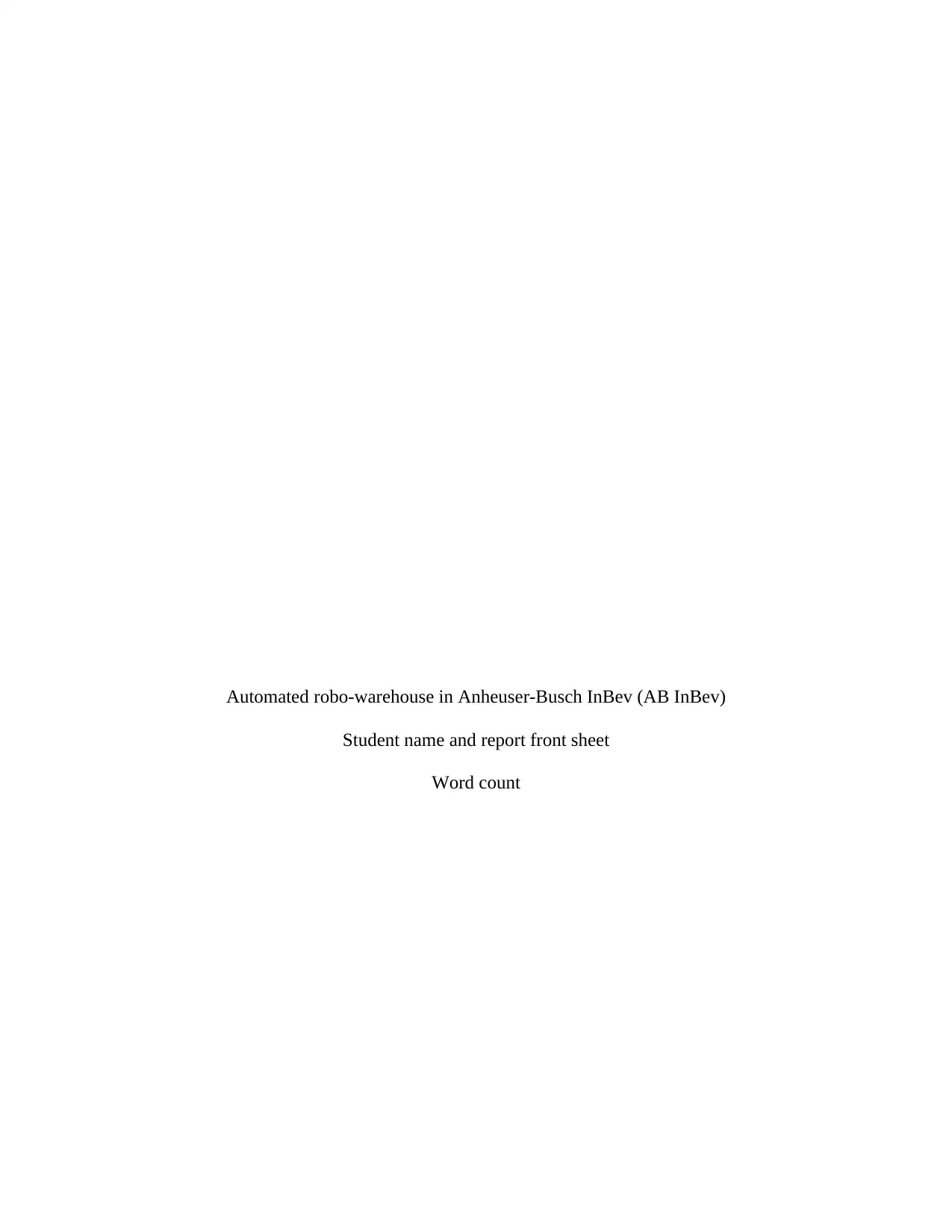
Automated robo-warehouse in Anheuser-Busch InBev (AB InBev)
Student name and report front sheet
Word count
Student name and report front sheet
Word count
Paraphrase This Document
Need a fresh take? Get an instant paraphrase of this document with our AI Paraphraser
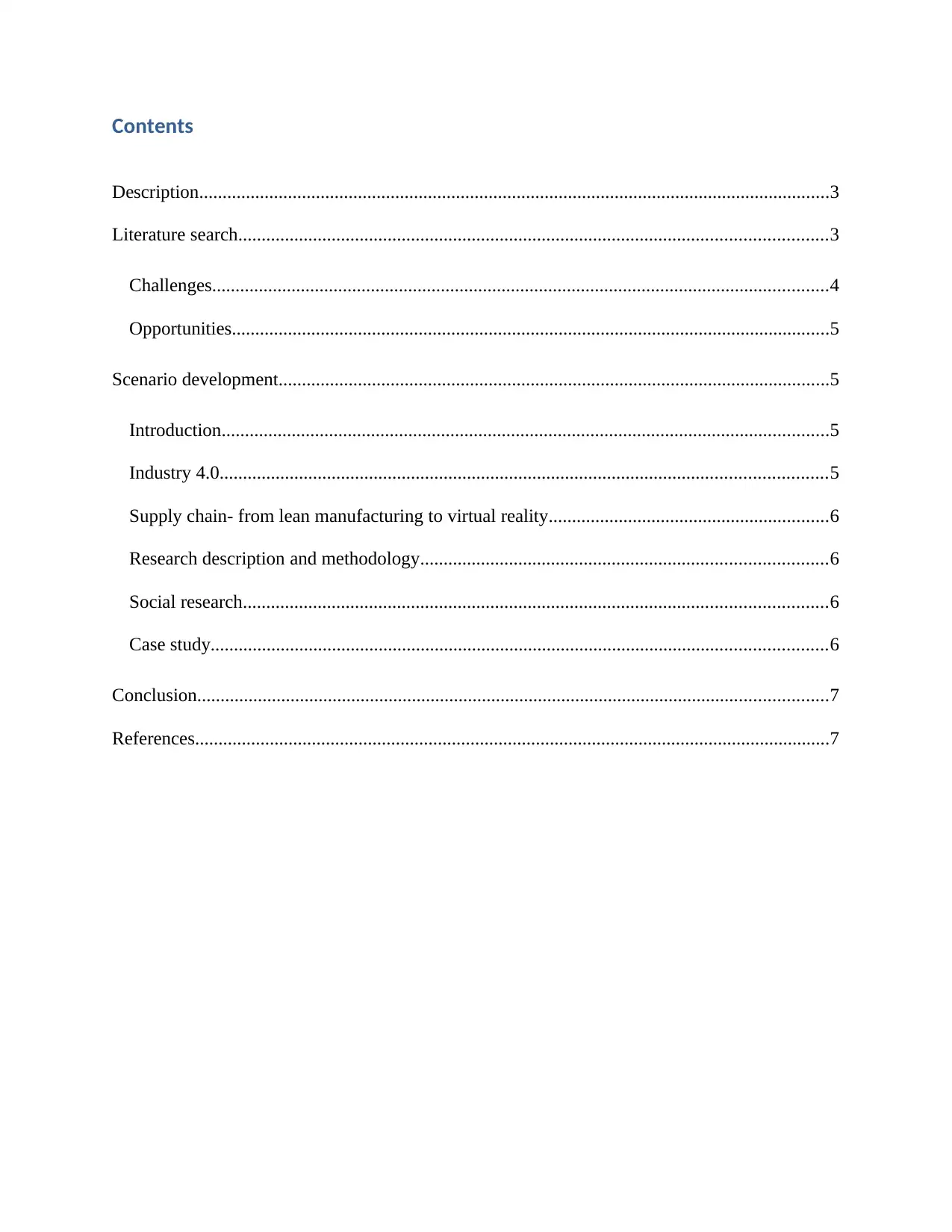
Contents
Description.......................................................................................................................................3
Literature search..............................................................................................................................3
Challenges....................................................................................................................................4
Opportunities................................................................................................................................5
Scenario development......................................................................................................................5
Introduction..................................................................................................................................5
Industry 4.0..................................................................................................................................5
Supply chain- from lean manufacturing to virtual reality............................................................6
Research description and methodology.......................................................................................6
Social research.............................................................................................................................6
Case study....................................................................................................................................6
Conclusion.......................................................................................................................................7
References........................................................................................................................................7
Description.......................................................................................................................................3
Literature search..............................................................................................................................3
Challenges....................................................................................................................................4
Opportunities................................................................................................................................5
Scenario development......................................................................................................................5
Introduction..................................................................................................................................5
Industry 4.0..................................................................................................................................5
Supply chain- from lean manufacturing to virtual reality............................................................6
Research description and methodology.......................................................................................6
Social research.............................................................................................................................6
Case study....................................................................................................................................6
Conclusion.......................................................................................................................................7
References........................................................................................................................................7
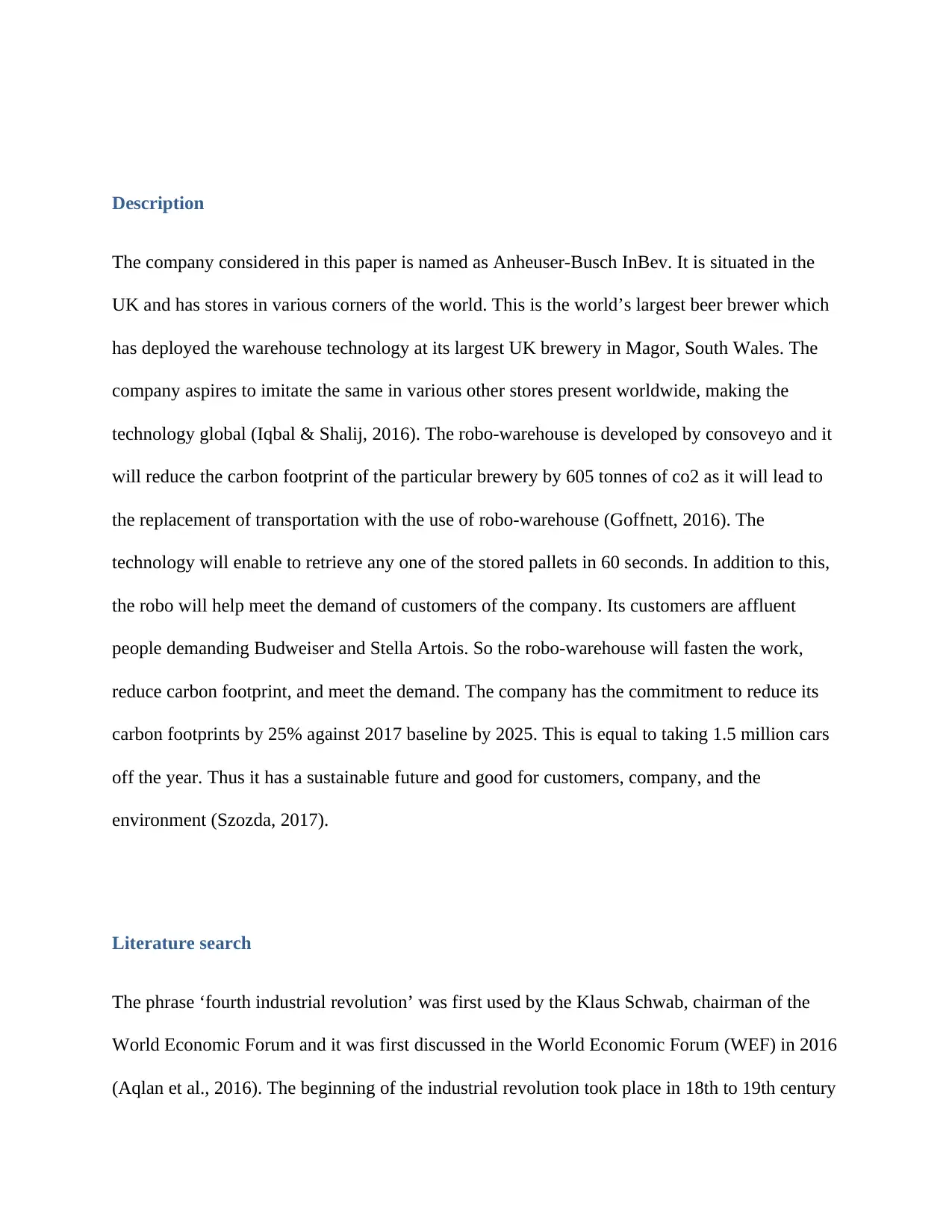
Description
The company considered in this paper is named as Anheuser-Busch InBev. It is situated in the
UK and has stores in various corners of the world. This is the world’s largest beer brewer which
has deployed the warehouse technology at its largest UK brewery in Magor, South Wales. The
company aspires to imitate the same in various other stores present worldwide, making the
technology global (Iqbal & Shalij, 2016). The robo-warehouse is developed by consoveyo and it
will reduce the carbon footprint of the particular brewery by 605 tonnes of co2 as it will lead to
the replacement of transportation with the use of robo-warehouse (Goffnett, 2016). The
technology will enable to retrieve any one of the stored pallets in 60 seconds. In addition to this,
the robo will help meet the demand of customers of the company. Its customers are affluent
people demanding Budweiser and Stella Artois. So the robo-warehouse will fasten the work,
reduce carbon footprint, and meet the demand. The company has the commitment to reduce its
carbon footprints by 25% against 2017 baseline by 2025. This is equal to taking 1.5 million cars
off the year. Thus it has a sustainable future and good for customers, company, and the
environment (Szozda, 2017).
Literature search
The phrase ‘fourth industrial revolution’ was first used by the Klaus Schwab, chairman of the
World Economic Forum and it was first discussed in the World Economic Forum (WEF) in 2016
(Aqlan et al., 2016). The beginning of the industrial revolution took place in 18th to 19th century
The company considered in this paper is named as Anheuser-Busch InBev. It is situated in the
UK and has stores in various corners of the world. This is the world’s largest beer brewer which
has deployed the warehouse technology at its largest UK brewery in Magor, South Wales. The
company aspires to imitate the same in various other stores present worldwide, making the
technology global (Iqbal & Shalij, 2016). The robo-warehouse is developed by consoveyo and it
will reduce the carbon footprint of the particular brewery by 605 tonnes of co2 as it will lead to
the replacement of transportation with the use of robo-warehouse (Goffnett, 2016). The
technology will enable to retrieve any one of the stored pallets in 60 seconds. In addition to this,
the robo will help meet the demand of customers of the company. Its customers are affluent
people demanding Budweiser and Stella Artois. So the robo-warehouse will fasten the work,
reduce carbon footprint, and meet the demand. The company has the commitment to reduce its
carbon footprints by 25% against 2017 baseline by 2025. This is equal to taking 1.5 million cars
off the year. Thus it has a sustainable future and good for customers, company, and the
environment (Szozda, 2017).
Literature search
The phrase ‘fourth industrial revolution’ was first used by the Klaus Schwab, chairman of the
World Economic Forum and it was first discussed in the World Economic Forum (WEF) in 2016
(Aqlan et al., 2016). The beginning of the industrial revolution took place in 18th to 19th century
⊘ This is a preview!⊘
Do you want full access?
Subscribe today to unlock all pages.

Trusted by 1+ million students worldwide
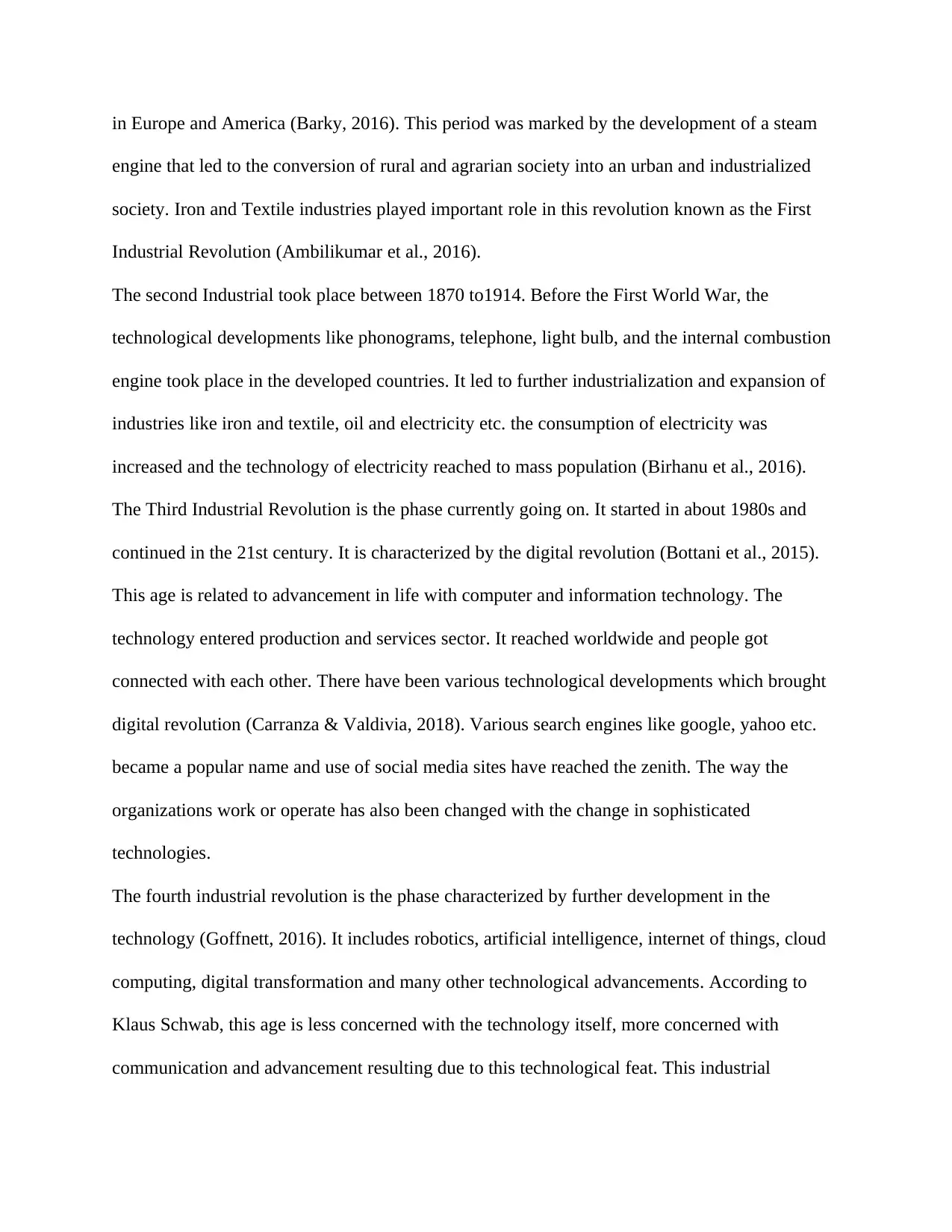
in Europe and America (Barky, 2016). This period was marked by the development of a steam
engine that led to the conversion of rural and agrarian society into an urban and industrialized
society. Iron and Textile industries played important role in this revolution known as the First
Industrial Revolution (Ambilikumar et al., 2016).
The second Industrial took place between 1870 to1914. Before the First World War, the
technological developments like phonograms, telephone, light bulb, and the internal combustion
engine took place in the developed countries. It led to further industrialization and expansion of
industries like iron and textile, oil and electricity etc. the consumption of electricity was
increased and the technology of electricity reached to mass population (Birhanu et al., 2016).
The Third Industrial Revolution is the phase currently going on. It started in about 1980s and
continued in the 21st century. It is characterized by the digital revolution (Bottani et al., 2015).
This age is related to advancement in life with computer and information technology. The
technology entered production and services sector. It reached worldwide and people got
connected with each other. There have been various technological developments which brought
digital revolution (Carranza & Valdivia, 2018). Various search engines like google, yahoo etc.
became a popular name and use of social media sites have reached the zenith. The way the
organizations work or operate has also been changed with the change in sophisticated
technologies.
The fourth industrial revolution is the phase characterized by further development in the
technology (Goffnett, 2016). It includes robotics, artificial intelligence, internet of things, cloud
computing, digital transformation and many other technological advancements. According to
Klaus Schwab, this age is less concerned with the technology itself, more concerned with
communication and advancement resulting due to this technological feat. This industrial
engine that led to the conversion of rural and agrarian society into an urban and industrialized
society. Iron and Textile industries played important role in this revolution known as the First
Industrial Revolution (Ambilikumar et al., 2016).
The second Industrial took place between 1870 to1914. Before the First World War, the
technological developments like phonograms, telephone, light bulb, and the internal combustion
engine took place in the developed countries. It led to further industrialization and expansion of
industries like iron and textile, oil and electricity etc. the consumption of electricity was
increased and the technology of electricity reached to mass population (Birhanu et al., 2016).
The Third Industrial Revolution is the phase currently going on. It started in about 1980s and
continued in the 21st century. It is characterized by the digital revolution (Bottani et al., 2015).
This age is related to advancement in life with computer and information technology. The
technology entered production and services sector. It reached worldwide and people got
connected with each other. There have been various technological developments which brought
digital revolution (Carranza & Valdivia, 2018). Various search engines like google, yahoo etc.
became a popular name and use of social media sites have reached the zenith. The way the
organizations work or operate has also been changed with the change in sophisticated
technologies.
The fourth industrial revolution is the phase characterized by further development in the
technology (Goffnett, 2016). It includes robotics, artificial intelligence, internet of things, cloud
computing, digital transformation and many other technological advancements. According to
Klaus Schwab, this age is less concerned with the technology itself, more concerned with
communication and advancement resulting due to this technological feat. This industrial
Paraphrase This Document
Need a fresh take? Get an instant paraphrase of this document with our AI Paraphraser
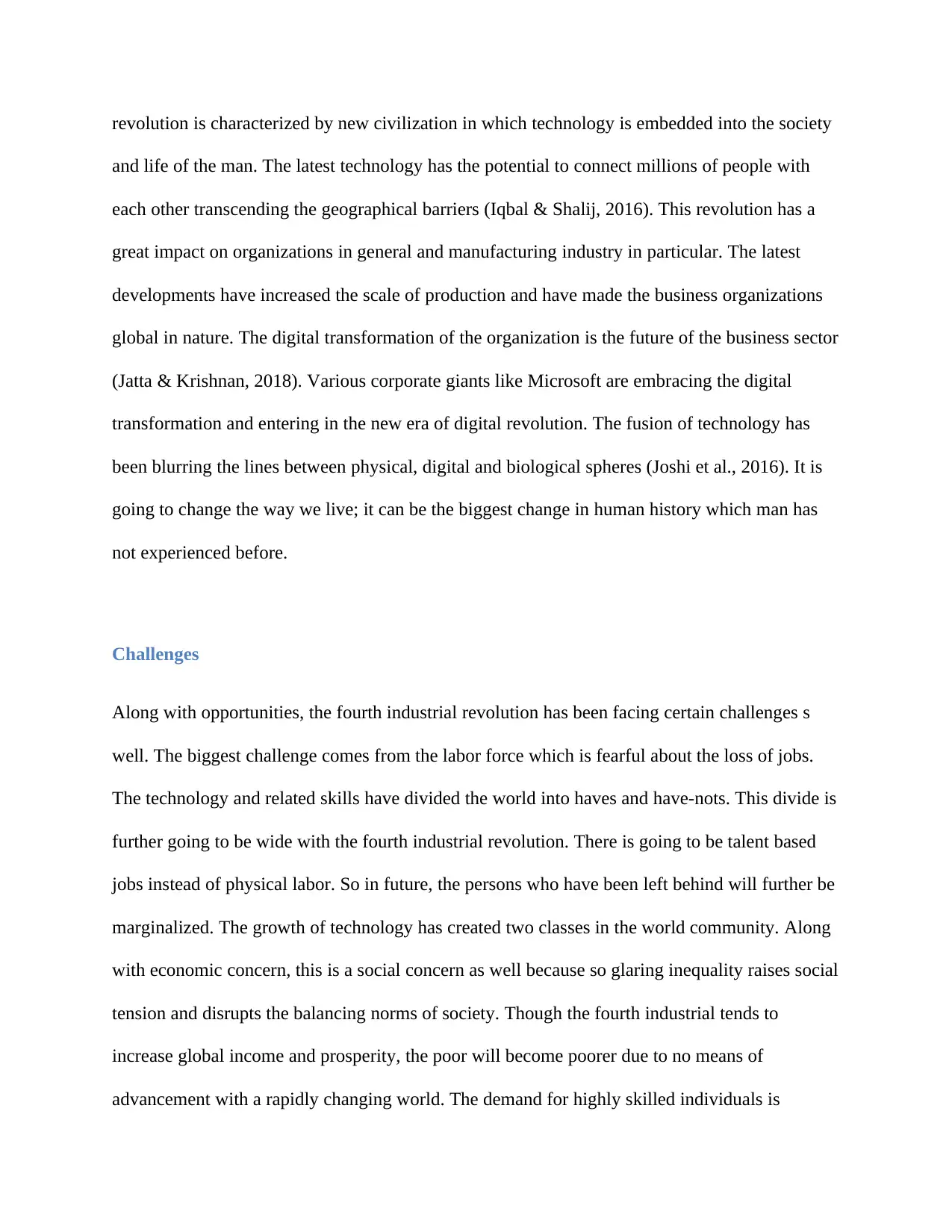
revolution is characterized by new civilization in which technology is embedded into the society
and life of the man. The latest technology has the potential to connect millions of people with
each other transcending the geographical barriers (Iqbal & Shalij, 2016). This revolution has a
great impact on organizations in general and manufacturing industry in particular. The latest
developments have increased the scale of production and have made the business organizations
global in nature. The digital transformation of the organization is the future of the business sector
(Jatta & Krishnan, 2018). Various corporate giants like Microsoft are embracing the digital
transformation and entering in the new era of digital revolution. The fusion of technology has
been blurring the lines between physical, digital and biological spheres (Joshi et al., 2016). It is
going to change the way we live; it can be the biggest change in human history which man has
not experienced before.
Challenges
Along with opportunities, the fourth industrial revolution has been facing certain challenges s
well. The biggest challenge comes from the labor force which is fearful about the loss of jobs.
The technology and related skills have divided the world into haves and have-nots. This divide is
further going to be wide with the fourth industrial revolution. There is going to be talent based
jobs instead of physical labor. So in future, the persons who have been left behind will further be
marginalized. The growth of technology has created two classes in the world community. Along
with economic concern, this is a social concern as well because so glaring inequality raises social
tension and disrupts the balancing norms of society. Though the fourth industrial tends to
increase global income and prosperity, the poor will become poorer due to no means of
advancement with a rapidly changing world. The demand for highly skilled individuals is
and life of the man. The latest technology has the potential to connect millions of people with
each other transcending the geographical barriers (Iqbal & Shalij, 2016). This revolution has a
great impact on organizations in general and manufacturing industry in particular. The latest
developments have increased the scale of production and have made the business organizations
global in nature. The digital transformation of the organization is the future of the business sector
(Jatta & Krishnan, 2018). Various corporate giants like Microsoft are embracing the digital
transformation and entering in the new era of digital revolution. The fusion of technology has
been blurring the lines between physical, digital and biological spheres (Joshi et al., 2016). It is
going to change the way we live; it can be the biggest change in human history which man has
not experienced before.
Challenges
Along with opportunities, the fourth industrial revolution has been facing certain challenges s
well. The biggest challenge comes from the labor force which is fearful about the loss of jobs.
The technology and related skills have divided the world into haves and have-nots. This divide is
further going to be wide with the fourth industrial revolution. There is going to be talent based
jobs instead of physical labor. So in future, the persons who have been left behind will further be
marginalized. The growth of technology has created two classes in the world community. Along
with economic concern, this is a social concern as well because so glaring inequality raises social
tension and disrupts the balancing norms of society. Though the fourth industrial tends to
increase global income and prosperity, the poor will become poorer due to no means of
advancement with a rapidly changing world. The demand for highly skilled individuals is
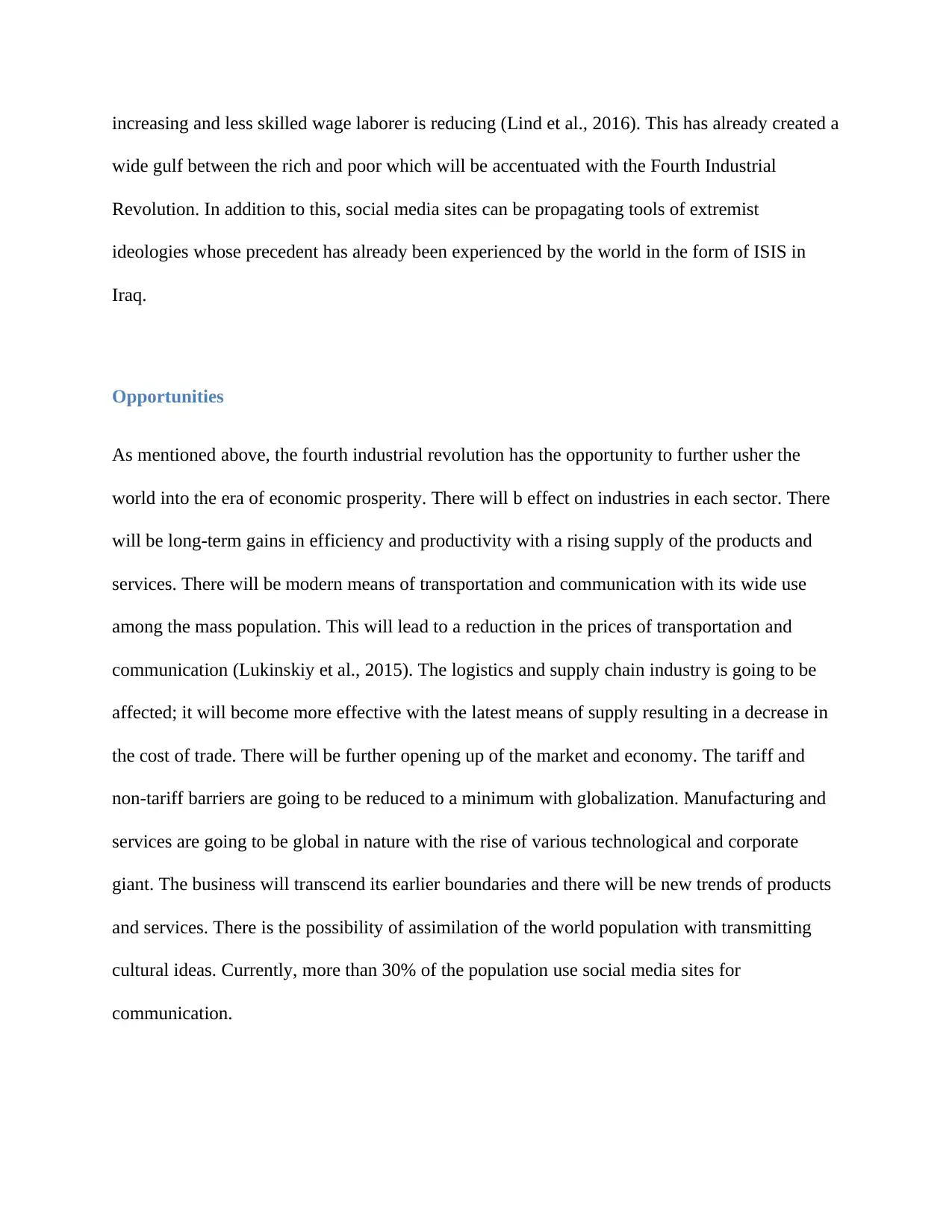
increasing and less skilled wage laborer is reducing (Lind et al., 2016). This has already created a
wide gulf between the rich and poor which will be accentuated with the Fourth Industrial
Revolution. In addition to this, social media sites can be propagating tools of extremist
ideologies whose precedent has already been experienced by the world in the form of ISIS in
Iraq.
Opportunities
As mentioned above, the fourth industrial revolution has the opportunity to further usher the
world into the era of economic prosperity. There will b effect on industries in each sector. There
will be long-term gains in efficiency and productivity with a rising supply of the products and
services. There will be modern means of transportation and communication with its wide use
among the mass population. This will lead to a reduction in the prices of transportation and
communication (Lukinskiy et al., 2015). The logistics and supply chain industry is going to be
affected; it will become more effective with the latest means of supply resulting in a decrease in
the cost of trade. There will be further opening up of the market and economy. The tariff and
non-tariff barriers are going to be reduced to a minimum with globalization. Manufacturing and
services are going to be global in nature with the rise of various technological and corporate
giant. The business will transcend its earlier boundaries and there will be new trends of products
and services. There is the possibility of assimilation of the world population with transmitting
cultural ideas. Currently, more than 30% of the population use social media sites for
communication.
wide gulf between the rich and poor which will be accentuated with the Fourth Industrial
Revolution. In addition to this, social media sites can be propagating tools of extremist
ideologies whose precedent has already been experienced by the world in the form of ISIS in
Iraq.
Opportunities
As mentioned above, the fourth industrial revolution has the opportunity to further usher the
world into the era of economic prosperity. There will b effect on industries in each sector. There
will be long-term gains in efficiency and productivity with a rising supply of the products and
services. There will be modern means of transportation and communication with its wide use
among the mass population. This will lead to a reduction in the prices of transportation and
communication (Lukinskiy et al., 2015). The logistics and supply chain industry is going to be
affected; it will become more effective with the latest means of supply resulting in a decrease in
the cost of trade. There will be further opening up of the market and economy. The tariff and
non-tariff barriers are going to be reduced to a minimum with globalization. Manufacturing and
services are going to be global in nature with the rise of various technological and corporate
giant. The business will transcend its earlier boundaries and there will be new trends of products
and services. There is the possibility of assimilation of the world population with transmitting
cultural ideas. Currently, more than 30% of the population use social media sites for
communication.
⊘ This is a preview!⊘
Do you want full access?
Subscribe today to unlock all pages.

Trusted by 1+ million students worldwide
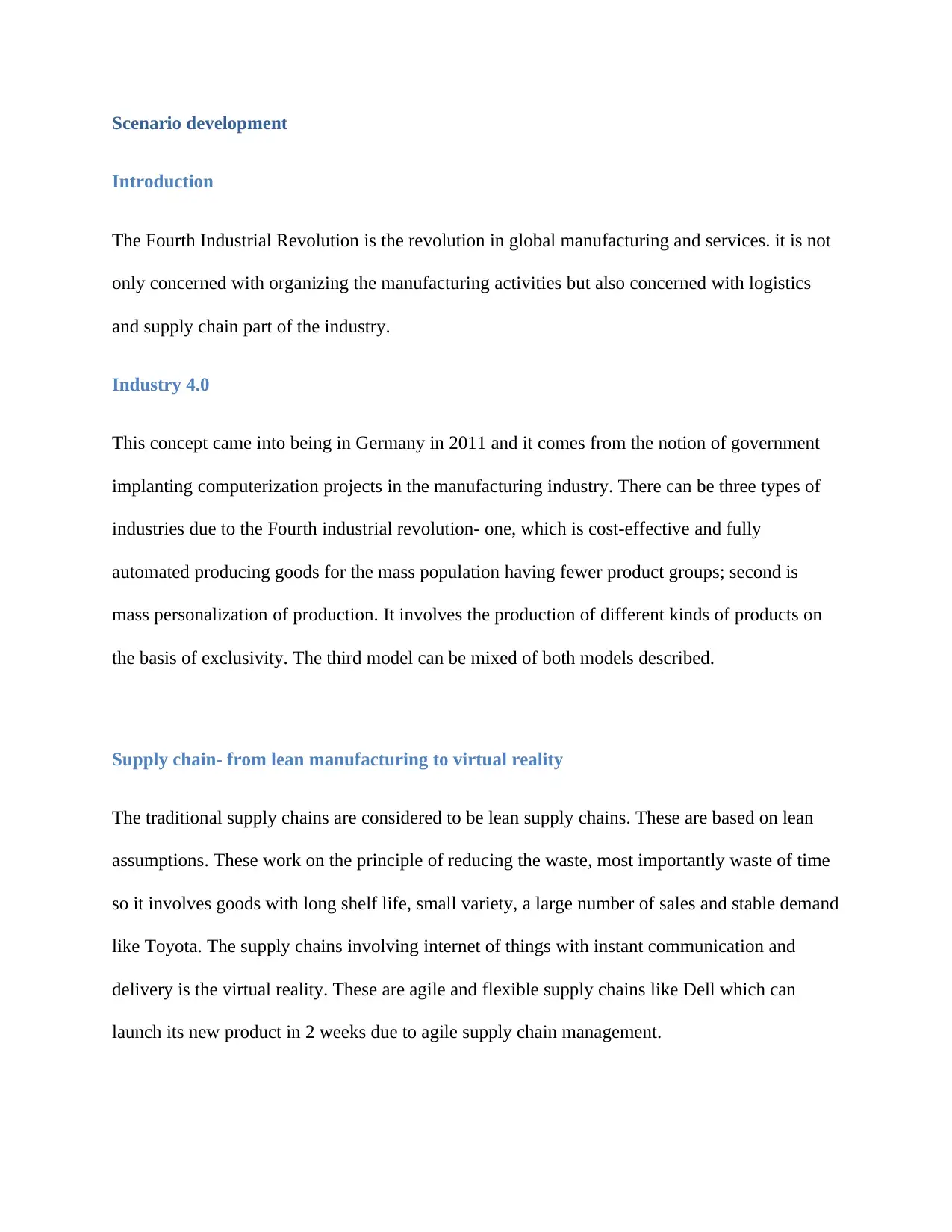
Scenario development
Introduction
The Fourth Industrial Revolution is the revolution in global manufacturing and services. it is not
only concerned with organizing the manufacturing activities but also concerned with logistics
and supply chain part of the industry.
Industry 4.0
This concept came into being in Germany in 2011 and it comes from the notion of government
implanting computerization projects in the manufacturing industry. There can be three types of
industries due to the Fourth industrial revolution- one, which is cost-effective and fully
automated producing goods for the mass population having fewer product groups; second is
mass personalization of production. It involves the production of different kinds of products on
the basis of exclusivity. The third model can be mixed of both models described.
Supply chain- from lean manufacturing to virtual reality
The traditional supply chains are considered to be lean supply chains. These are based on lean
assumptions. These work on the principle of reducing the waste, most importantly waste of time
so it involves goods with long shelf life, small variety, a large number of sales and stable demand
like Toyota. The supply chains involving internet of things with instant communication and
delivery is the virtual reality. These are agile and flexible supply chains like Dell which can
launch its new product in 2 weeks due to agile supply chain management.
Introduction
The Fourth Industrial Revolution is the revolution in global manufacturing and services. it is not
only concerned with organizing the manufacturing activities but also concerned with logistics
and supply chain part of the industry.
Industry 4.0
This concept came into being in Germany in 2011 and it comes from the notion of government
implanting computerization projects in the manufacturing industry. There can be three types of
industries due to the Fourth industrial revolution- one, which is cost-effective and fully
automated producing goods for the mass population having fewer product groups; second is
mass personalization of production. It involves the production of different kinds of products on
the basis of exclusivity. The third model can be mixed of both models described.
Supply chain- from lean manufacturing to virtual reality
The traditional supply chains are considered to be lean supply chains. These are based on lean
assumptions. These work on the principle of reducing the waste, most importantly waste of time
so it involves goods with long shelf life, small variety, a large number of sales and stable demand
like Toyota. The supply chains involving internet of things with instant communication and
delivery is the virtual reality. These are agile and flexible supply chains like Dell which can
launch its new product in 2 weeks due to agile supply chain management.
Paraphrase This Document
Need a fresh take? Get an instant paraphrase of this document with our AI Paraphraser
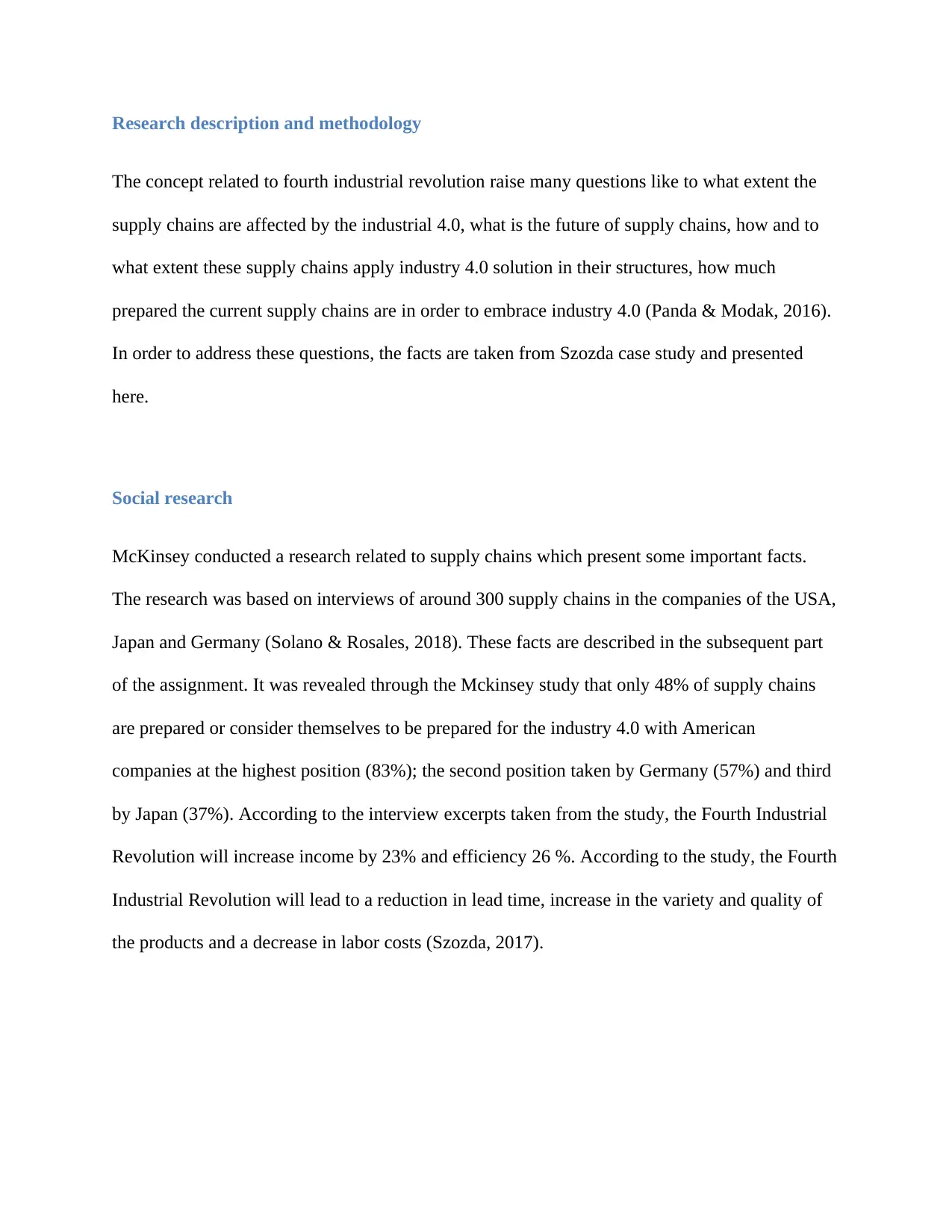
Research description and methodology
The concept related to fourth industrial revolution raise many questions like to what extent the
supply chains are affected by the industrial 4.0, what is the future of supply chains, how and to
what extent these supply chains apply industry 4.0 solution in their structures, how much
prepared the current supply chains are in order to embrace industry 4.0 (Panda & Modak, 2016).
In order to address these questions, the facts are taken from Szozda case study and presented
here.
Social research
McKinsey conducted a research related to supply chains which present some important facts.
The research was based on interviews of around 300 supply chains in the companies of the USA,
Japan and Germany (Solano & Rosales, 2018). These facts are described in the subsequent part
of the assignment. It was revealed through the Mckinsey study that only 48% of supply chains
are prepared or consider themselves to be prepared for the industry 4.0 with American
companies at the highest position (83%); the second position taken by Germany (57%) and third
by Japan (37%). According to the interview excerpts taken from the study, the Fourth Industrial
Revolution will increase income by 23% and efficiency 26 %. According to the study, the Fourth
Industrial Revolution will lead to a reduction in lead time, increase in the variety and quality of
the products and a decrease in labor costs (Szozda, 2017).
The concept related to fourth industrial revolution raise many questions like to what extent the
supply chains are affected by the industrial 4.0, what is the future of supply chains, how and to
what extent these supply chains apply industry 4.0 solution in their structures, how much
prepared the current supply chains are in order to embrace industry 4.0 (Panda & Modak, 2016).
In order to address these questions, the facts are taken from Szozda case study and presented
here.
Social research
McKinsey conducted a research related to supply chains which present some important facts.
The research was based on interviews of around 300 supply chains in the companies of the USA,
Japan and Germany (Solano & Rosales, 2018). These facts are described in the subsequent part
of the assignment. It was revealed through the Mckinsey study that only 48% of supply chains
are prepared or consider themselves to be prepared for the industry 4.0 with American
companies at the highest position (83%); the second position taken by Germany (57%) and third
by Japan (37%). According to the interview excerpts taken from the study, the Fourth Industrial
Revolution will increase income by 23% and efficiency 26 %. According to the study, the Fourth
Industrial Revolution will lead to a reduction in lead time, increase in the variety and quality of
the products and a decrease in labor costs (Szozda, 2017).
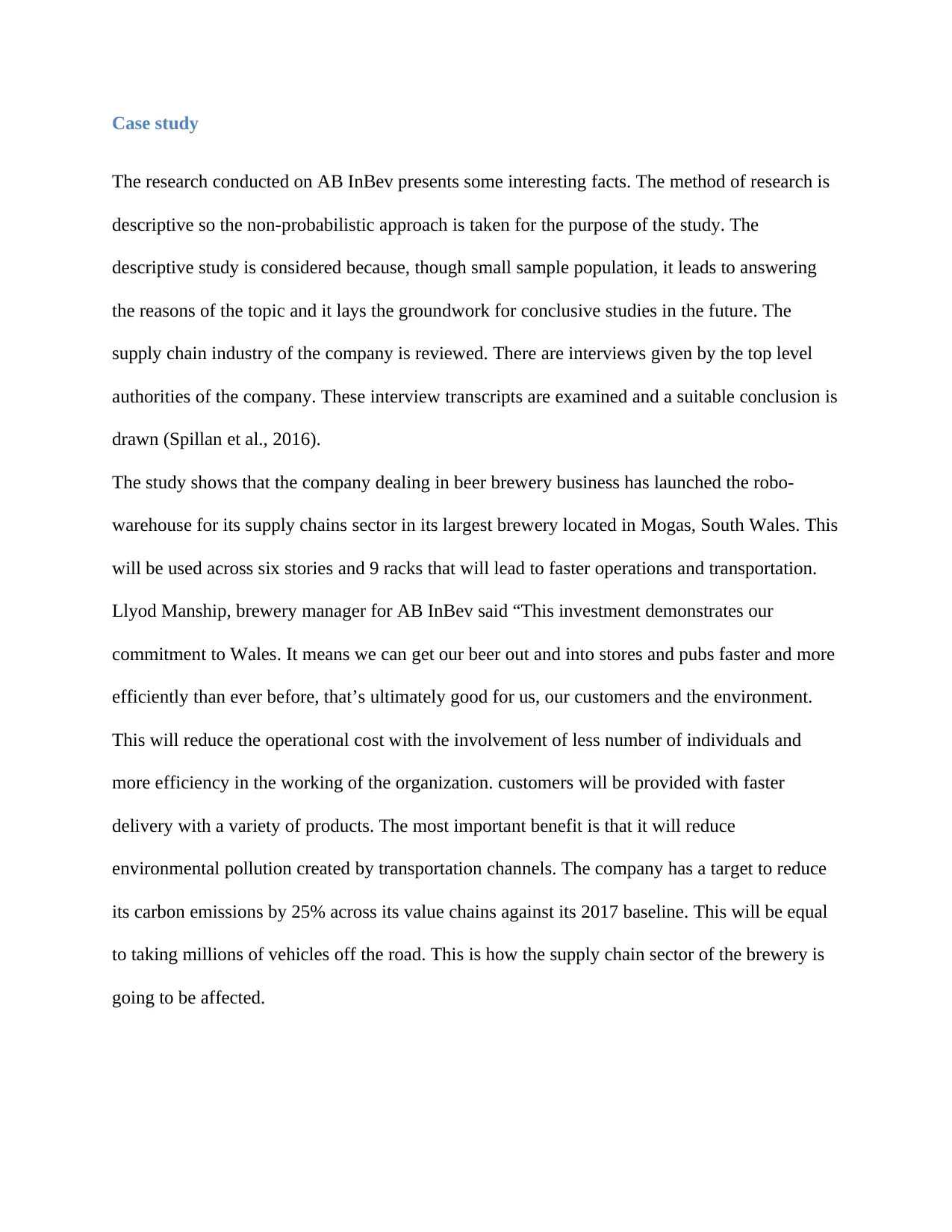
Case study
The research conducted on AB InBev presents some interesting facts. The method of research is
descriptive so the non-probabilistic approach is taken for the purpose of the study. The
descriptive study is considered because, though small sample population, it leads to answering
the reasons of the topic and it lays the groundwork for conclusive studies in the future. The
supply chain industry of the company is reviewed. There are interviews given by the top level
authorities of the company. These interview transcripts are examined and a suitable conclusion is
drawn (Spillan et al., 2016).
The study shows that the company dealing in beer brewery business has launched the robo-
warehouse for its supply chains sector in its largest brewery located in Mogas, South Wales. This
will be used across six stories and 9 racks that will lead to faster operations and transportation.
Llyod Manship, brewery manager for AB InBev said “This investment demonstrates our
commitment to Wales. It means we can get our beer out and into stores and pubs faster and more
efficiently than ever before, that’s ultimately good for us, our customers and the environment.
This will reduce the operational cost with the involvement of less number of individuals and
more efficiency in the working of the organization. customers will be provided with faster
delivery with a variety of products. The most important benefit is that it will reduce
environmental pollution created by transportation channels. The company has a target to reduce
its carbon emissions by 25% across its value chains against its 2017 baseline. This will be equal
to taking millions of vehicles off the road. This is how the supply chain sector of the brewery is
going to be affected.
The research conducted on AB InBev presents some interesting facts. The method of research is
descriptive so the non-probabilistic approach is taken for the purpose of the study. The
descriptive study is considered because, though small sample population, it leads to answering
the reasons of the topic and it lays the groundwork for conclusive studies in the future. The
supply chain industry of the company is reviewed. There are interviews given by the top level
authorities of the company. These interview transcripts are examined and a suitable conclusion is
drawn (Spillan et al., 2016).
The study shows that the company dealing in beer brewery business has launched the robo-
warehouse for its supply chains sector in its largest brewery located in Mogas, South Wales. This
will be used across six stories and 9 racks that will lead to faster operations and transportation.
Llyod Manship, brewery manager for AB InBev said “This investment demonstrates our
commitment to Wales. It means we can get our beer out and into stores and pubs faster and more
efficiently than ever before, that’s ultimately good for us, our customers and the environment.
This will reduce the operational cost with the involvement of less number of individuals and
more efficiency in the working of the organization. customers will be provided with faster
delivery with a variety of products. The most important benefit is that it will reduce
environmental pollution created by transportation channels. The company has a target to reduce
its carbon emissions by 25% across its value chains against its 2017 baseline. This will be equal
to taking millions of vehicles off the road. This is how the supply chain sector of the brewery is
going to be affected.
⊘ This is a preview!⊘
Do you want full access?
Subscribe today to unlock all pages.

Trusted by 1+ million students worldwide
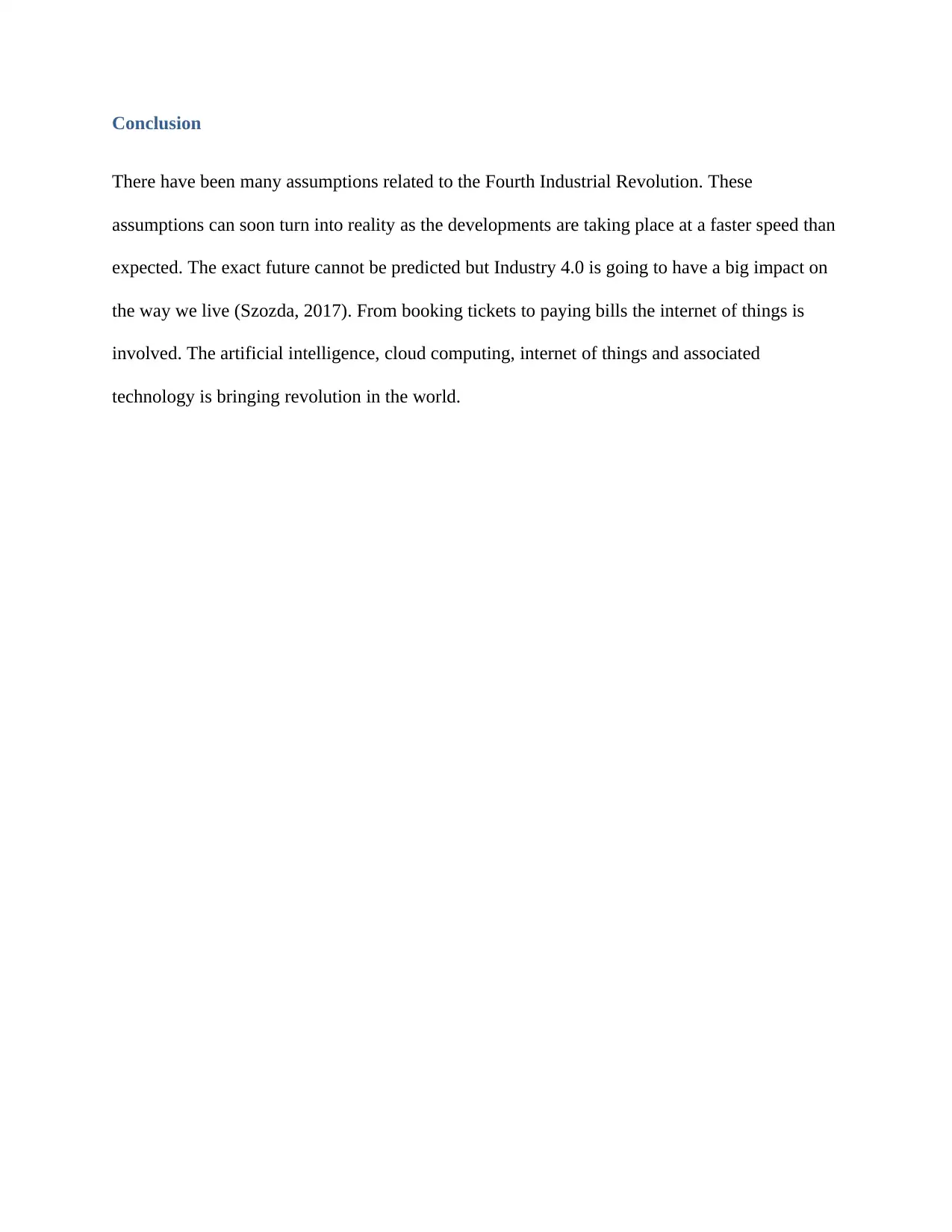
Conclusion
There have been many assumptions related to the Fourth Industrial Revolution. These
assumptions can soon turn into reality as the developments are taking place at a faster speed than
expected. The exact future cannot be predicted but Industry 4.0 is going to have a big impact on
the way we live (Szozda, 2017). From booking tickets to paying bills the internet of things is
involved. The artificial intelligence, cloud computing, internet of things and associated
technology is bringing revolution in the world.
There have been many assumptions related to the Fourth Industrial Revolution. These
assumptions can soon turn into reality as the developments are taking place at a faster speed than
expected. The exact future cannot be predicted but Industry 4.0 is going to have a big impact on
the way we live (Szozda, 2017). From booking tickets to paying bills the internet of things is
involved. The artificial intelligence, cloud computing, internet of things and associated
technology is bringing revolution in the world.
Paraphrase This Document
Need a fresh take? Get an instant paraphrase of this document with our AI Paraphraser
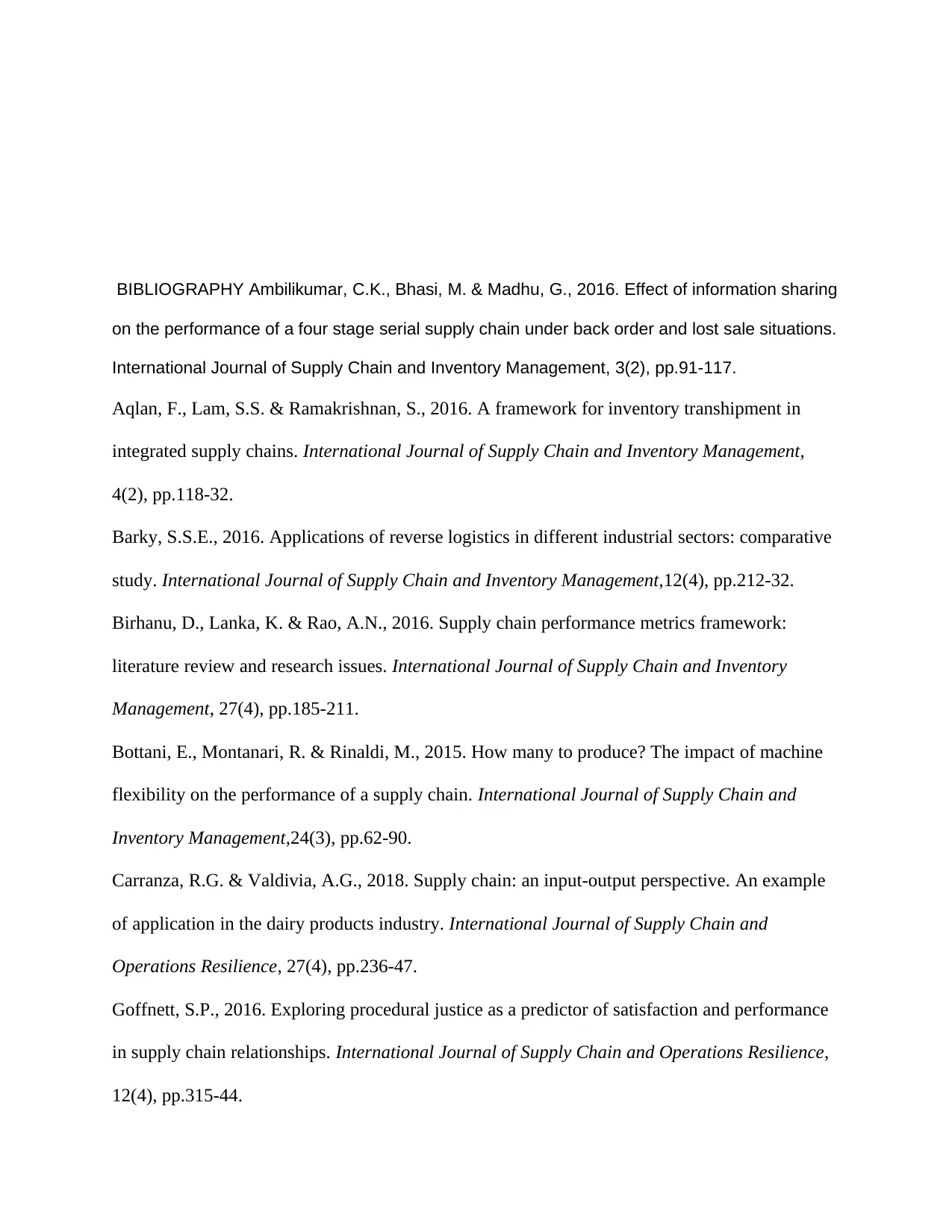
BIBLIOGRAPHY Ambilikumar, C.K., Bhasi, M. & Madhu, G., 2016. Effect of information sharing
on the performance of a four stage serial supply chain under back order and lost sale situations.
International Journal of Supply Chain and Inventory Management, 3(2), pp.91-117.
Aqlan, F., Lam, S.S. & Ramakrishnan, S., 2016. A framework for inventory transhipment in
integrated supply chains. International Journal of Supply Chain and Inventory Management,
4(2), pp.118-32.
Barky, S.S.E., 2016. Applications of reverse logistics in different industrial sectors: comparative
study. International Journal of Supply Chain and Inventory Management,12(4), pp.212-32.
Birhanu, D., Lanka, K. & Rao, A.N., 2016. Supply chain performance metrics framework:
literature review and research issues. International Journal of Supply Chain and Inventory
Management, 27(4), pp.185-211.
Bottani, E., Montanari, R. & Rinaldi, M., 2015. How many to produce? The impact of machine
flexibility on the performance of a supply chain. International Journal of Supply Chain and
Inventory Management,24(3), pp.62-90.
Carranza, R.G. & Valdivia, A.G., 2018. Supply chain: an input-output perspective. An example
of application in the dairy products industry. International Journal of Supply Chain and
Operations Resilience, 27(4), pp.236-47.
Goffnett, S.P., 2016. Exploring procedural justice as a predictor of satisfaction and performance
in supply chain relationships. International Journal of Supply Chain and Operations Resilience,
12(4), pp.315-44.
on the performance of a four stage serial supply chain under back order and lost sale situations.
International Journal of Supply Chain and Inventory Management, 3(2), pp.91-117.
Aqlan, F., Lam, S.S. & Ramakrishnan, S., 2016. A framework for inventory transhipment in
integrated supply chains. International Journal of Supply Chain and Inventory Management,
4(2), pp.118-32.
Barky, S.S.E., 2016. Applications of reverse logistics in different industrial sectors: comparative
study. International Journal of Supply Chain and Inventory Management,12(4), pp.212-32.
Birhanu, D., Lanka, K. & Rao, A.N., 2016. Supply chain performance metrics framework:
literature review and research issues. International Journal of Supply Chain and Inventory
Management, 27(4), pp.185-211.
Bottani, E., Montanari, R. & Rinaldi, M., 2015. How many to produce? The impact of machine
flexibility on the performance of a supply chain. International Journal of Supply Chain and
Inventory Management,24(3), pp.62-90.
Carranza, R.G. & Valdivia, A.G., 2018. Supply chain: an input-output perspective. An example
of application in the dairy products industry. International Journal of Supply Chain and
Operations Resilience, 27(4), pp.236-47.
Goffnett, S.P., 2016. Exploring procedural justice as a predictor of satisfaction and performance
in supply chain relationships. International Journal of Supply Chain and Operations Resilience,
12(4), pp.315-44.
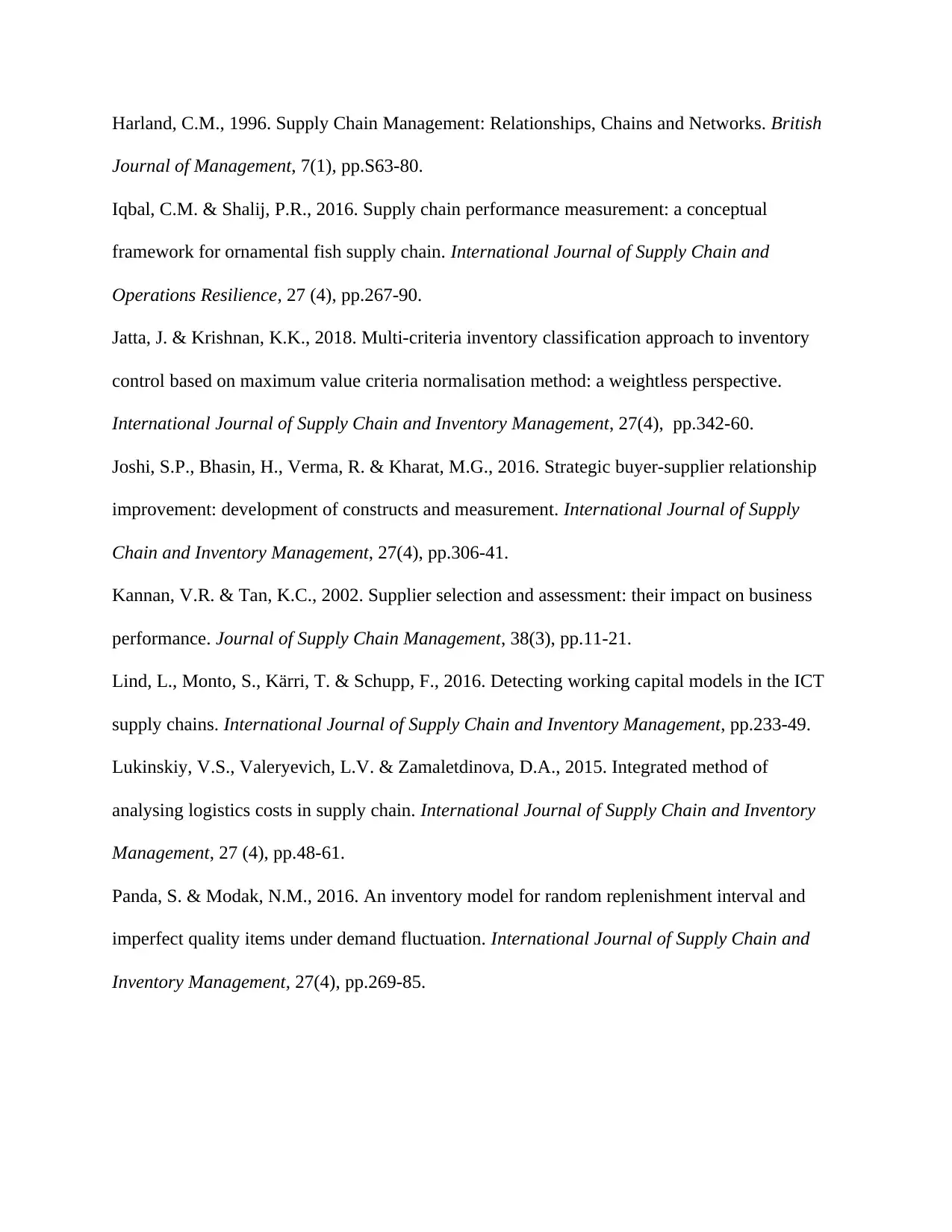
Harland, C.M., 1996. Supply Chain Management: Relationships, Chains and Networks. British
Journal of Management, 7(1), pp.S63-80.
Iqbal, C.M. & Shalij, P.R., 2016. Supply chain performance measurement: a conceptual
framework for ornamental fish supply chain. International Journal of Supply Chain and
Operations Resilience, 27 (4), pp.267-90.
Jatta, J. & Krishnan, K.K., 2018. Multi-criteria inventory classification approach to inventory
control based on maximum value criteria normalisation method: a weightless perspective.
International Journal of Supply Chain and Inventory Management, 27(4), pp.342-60.
Joshi, S.P., Bhasin, H., Verma, R. & Kharat, M.G., 2016. Strategic buyer-supplier relationship
improvement: development of constructs and measurement. International Journal of Supply
Chain and Inventory Management, 27(4), pp.306-41.
Kannan, V.R. & Tan, K.C., 2002. Supplier selection and assessment: their impact on business
performance. Journal of Supply Chain Management, 38(3), pp.11-21.
Lind, L., Monto, S., Kärri, T. & Schupp, F., 2016. Detecting working capital models in the ICT
supply chains. International Journal of Supply Chain and Inventory Management, pp.233-49.
Lukinskiy, V.S., Valeryevich, L.V. & Zamaletdinova, D.A., 2015. Integrated method of
analysing logistics costs in supply chain. International Journal of Supply Chain and Inventory
Management, 27 (4), pp.48-61.
Panda, S. & Modak, N.M., 2016. An inventory model for random replenishment interval and
imperfect quality items under demand fluctuation. International Journal of Supply Chain and
Inventory Management, 27(4), pp.269-85.
Journal of Management, 7(1), pp.S63-80.
Iqbal, C.M. & Shalij, P.R., 2016. Supply chain performance measurement: a conceptual
framework for ornamental fish supply chain. International Journal of Supply Chain and
Operations Resilience, 27 (4), pp.267-90.
Jatta, J. & Krishnan, K.K., 2018. Multi-criteria inventory classification approach to inventory
control based on maximum value criteria normalisation method: a weightless perspective.
International Journal of Supply Chain and Inventory Management, 27(4), pp.342-60.
Joshi, S.P., Bhasin, H., Verma, R. & Kharat, M.G., 2016. Strategic buyer-supplier relationship
improvement: development of constructs and measurement. International Journal of Supply
Chain and Inventory Management, 27(4), pp.306-41.
Kannan, V.R. & Tan, K.C., 2002. Supplier selection and assessment: their impact on business
performance. Journal of Supply Chain Management, 38(3), pp.11-21.
Lind, L., Monto, S., Kärri, T. & Schupp, F., 2016. Detecting working capital models in the ICT
supply chains. International Journal of Supply Chain and Inventory Management, pp.233-49.
Lukinskiy, V.S., Valeryevich, L.V. & Zamaletdinova, D.A., 2015. Integrated method of
analysing logistics costs in supply chain. International Journal of Supply Chain and Inventory
Management, 27 (4), pp.48-61.
Panda, S. & Modak, N.M., 2016. An inventory model for random replenishment interval and
imperfect quality items under demand fluctuation. International Journal of Supply Chain and
Inventory Management, 27(4), pp.269-85.
⊘ This is a preview!⊘
Do you want full access?
Subscribe today to unlock all pages.

Trusted by 1+ million students worldwide
1 out of 13
Your All-in-One AI-Powered Toolkit for Academic Success.
+13062052269
info@desklib.com
Available 24*7 on WhatsApp / Email
![[object Object]](/_next/static/media/star-bottom.7253800d.svg)
Unlock your academic potential
Copyright © 2020–2025 A2Z Services. All Rights Reserved. Developed and managed by ZUCOL.